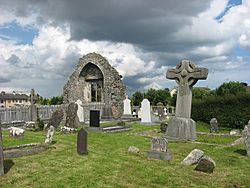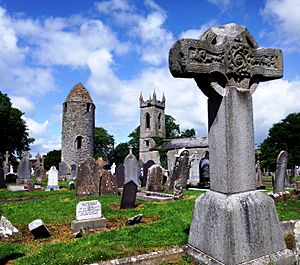Dromiskin Monastery facts for kids
| Druim-enesclaind Druim-ineascluin Droim Ineasclainn |
|

Church remnants and high cross
|
|
| Monastery information | |
|---|---|
| Other names | Drumiskin |
| Established | 6th century |
| Disestablished | 12th century |
| Diocese | Armagh |
| People | |
| Founder(s) | Lugaid |
| Architecture | |
| Status | Inactive |
| Style | Celtic monastic |
| Site | |
| Location | Chapel Road, Dromiskin, County Louth |
| Coordinates | 53°55′19″N 6°23′54″W / 53.922003°N 6.398219°W |
| Visible remains | church, round tower, cross fragment |
| Public access | yes |
| Official name | Dromiskin |
| Reference no. | 92 |
Dromiskin Monastery is a very old monastery in Dromiskin, County Louth, Ireland. It is also a special National Monument, which means it's protected because of its history. This ancient site has parts of a church, a tall round tower, and a beautiful stone cross still standing today.
Contents
Where is Dromiskin Monastery?
Dromiskin Monastery is right in the middle of Dromiskin village. It sits between two rivers, the River Fane and the River Glyde. It is also about 1.5 kilometers (about 1 mile) west of the Irish Sea coast.
A Look at Its History
The monastery at Dromiskin was started a very long time ago, in the 500s or 600s. Some people believe it was founded by Lugaid, a follower of Saint Patrick. Others say it was started by Rónán, who passed away in 664.
Viking Attacks and Changes
In the 800s, a tall round tower was built at Dromiskin. This tower was likely used for protection and as a bell tower. Sadly, the monastery faced many attacks over the years. Vikings burned Dromiskin in 833 and attacked it again in 978. Irish groups also plundered the monastery in 908 and 1043. Despite these challenges, Dromiskin Monastery continued to operate until the 1100s.
What You Can See Today
Even though it's very old, you can still see parts of the original buildings at Dromiskin.
The Round Tower
The round tower at Dromiskin is about 15.25 meters (50 feet) tall. It has a pointy top and a special doorway that is about 3.7 meters (12 feet) above the ground. The top part of the tower was rebuilt around the 1100s. It was used as a bell tower for many centuries, right up until the 1800s.
The High Cross
There is also a special stone high cross from the 900s. The arms of the cross are very old, but the main part of the cross was replaced in 1918. Some stories connect this cross to Áed Findliath, who was a High King of Ireland in the 800s. One part of the cross is thought to show David giving Goliath's head to Saul. You can also see carvings of dragons and a crucifixion scene on the cross.
The Church Remains
Today, you can still see the front wall (gable) and the foundations of a church that was built in the 1100s. It also has a window that was added in the 1400s.




